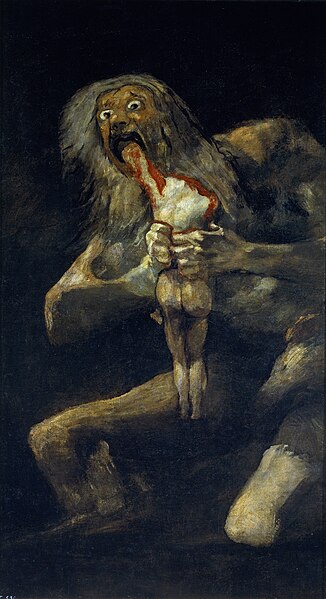

Juan Carlos had to be back in Madrid at 10:00 AM to assist at a baptism at his church, so we had to get up at 5:00 in the morning and hit the road. I think Terry slept most of the way back, and I nodded off a little myself.
The day we arrived, while we were driving back from the airport, and Juan Carlos was pointing out points of interest, he mentioned the Museo del Prado (w), a famous art museum, and I said I wanted to go there. So after Juan Carlos came back from church, we spent the rest of the afternoon wandering the halls of the Prado.
While walking from the car to the museum entrance, I took these two pictures of a large impressive church, which I later found out was the Iglesia de San Jeronimo el Real (Church of Saint Jerome the Royal):


I mentioned earlier that I found Juan Carlos to be very learned, especially about Spanish art and history. This visit to the Prado was where I found that out. He led me through the museum, pointing out especially noteworthy artworks, and trying as best as he could to tell me about them. I wished either his English or my Spanish was better, because I only understood a small amount of what he was saying, but it was enough to impress me with the depth of his knowledge.
Wandering around the museum, I was almost overwhelmed by the volume of artwork on display. It was especially interesting to run across several famous paintings that I'd seen in books, or on the internet. I didn't take pictures of them, but they're all available on the internet. Here are a few:

La Maja Desnuda by Francisco Goya

La Maja Vestida by Francisco Goya

The Garden Of Earthly Delights by Hieronymus Bosch

Adam And Eve by Albrecht Dürer

Saturn Devouring His Son by Francisco Goya
...as well as several others that I can't remember now - I should have taken better notes.
So here are some things I did take pictures of, like this statue of King Charles V. Take a look at what he's holding in his hand - it might be some kind of scepter or rod of office, or maybe it's the hilt of a sword, and the rest of the sword is missing. In any case, when I first saw it, I swear it looked like he was holding a microphone!

This large room contained statues of the nine Muses:

And here are four paintings that I took pictures of just because they appealed to me:

Christ, Man of Sorrows by Luis de Morales

The Apparition of Saint Peter to Saint Peter Nolasco by Francisco de Zurbarán

Winter Landscape (Madrid) by Aureliano de Bereute

The Mancorbo Pass in Picos de Europa by Carlos de Haes
But then I came across a painting that stopped me in my tracks:

My first thought was "Wait a minute, the Mona Lisa is in the Louvre, not the Prado!" But then I looked again, and I realized that this isn't the Mona Lisa. That is, it's not THE Mona Lisa - it's A Mona Lisa. There's more than one... who knew! According to Wikipedia (w), this version of the Mona Lisa was probably painted by a student in Leonardo da Vinci's workshop, but no one knows which one.
Actually, I think I prefer this Mona Lisa to the original:

As we left the Prado, I took this picture of a nearby building:

This is the Real Academia Española (Royal Spanish Academy), which, according to Wikipedia, "is Spain's official royal institution with a mission to ensure the stability of the Spanish language." In other words, they make the rules for the language. If you've ever wondered why Spanish words ending in "a" are feminine and words ending in "o" are masculine, but "programa" and "día" are masculine and "foto" and "mano" are feminine - it's because these folks said so!